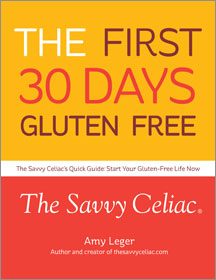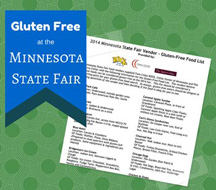Whether it is because of a celiac disease diagnosis or a gluten intolerance, making the transition to a lifestyle that is strictly gluten free is a challenge. You need to be educated about what gluten free means (food, nutrition, cross contamination), how it should benefit your health and the impact it can have on your family.
What does it mean to be Gluten Free?
At the very top level, gluten free means no wheat, barley and rye. But it also includes additives and ingredients like malt, possibly “spices” or natural flavorings that are often put in our food. While the FDA’s FALCPA has helped protect us from companies hiding wheat in our food, barley and rye are not included in the law. Strict gluten free eaters must check labels, especially these mystery areas on a regular basis. To help learn to read ingredient labels, take a look at Celiac.com’s Safe Ingredient list and Unsafe Ingredient list.
Oats are another beast all by themselves. Several years ago, it was decided that oats are inherently gluten free and safe to eat. HOWEVER, there is so much cross contamination with them in the growing and processing, that you must buy “Guaranteed Gluten Free” Oats. Sorry, Quaker doesn’t cut it. Nor do I purchase mainstream cereals that have oats or oat flour in them, because unless the label says gluten free oats — then you can always presume they’re regular oats.
Going Shopping for Gluten Free food
I try not to be a “glass is half full” person, but lower your expectations as you prepare to go shopping for gluten free food for the first time. Then you won’t be crying as you leave the grocery store like I did. I am happy to report many grocery stores have come a long way in the last decade so you should be able to find some gluten free items that will work for you.
Before you shop, check out this shopping list that the ROCK Twin Cities support group compiled in 2008. It’s a great list of yummy gluten free products. When you arrive to the store, ask you grocer about their gluten free foods. Most stores are getting on the gluten-free bandwagon and should be able to locate the areas. For example some have everything in one location , like the health food section. Others put the gluten free pasta in the pasta section, and gluten free cereal in the cereal section, and so on. Alleviate frustration and ask your service counter first.
One of the best things to do is lean on your fresh produce in the store as well as fresh meat and fish and dairy (if you can tolerate it). Processed foods get very dicey when it comes to gluten content. Gluten free processed food are often high in fat and sugar as well. Having those in moderation is key.
Gluten Free Flour. If you intend to bake, or make a gravy, having a gluten-free flour on hand is great. Many cookbooks have their own mixes. I use Bette Hagman’s flour mix of 6 cups white rice flour, 2 cups potato starch, 1 cup tapioca starch (I’ve recently been experimenting with sorghum and brown rice for added nutritional value). Or you can purchase a premixed flour. Some have Xanthan gum already in it. You will need Xanthan Gum as a binder for your baked goods. If it’s not in your flour you should add it. Approximately one teaspoon Xanthan Gum to every one cup of gluten free flour.
Preparing your Gluten Free Home
So you purchased a lot of gluten-free foods, now you need to keep them gluten free. That means doing as much as you can in your kitchen to eliminate the possibility of cross contamination. One speck of gluten will cause cross contamination. So you need to change out some of your kitchen supplies to maintain the “gluten-freeness” of your food — and educate your family so they don’t contaminate it.
1. Change out some kitchen supplies and food staples: You are now in the market for a new colander (residue in the corners), cutting boards (crumbs in the plastic or wood), toaster (crumbs everywhere), grill (possibly, you could use aluminum foil to protect your food if necessary) and food staples: butter, peanut butter, jam, mayonnaise, cream cheese, basically anything that could have been double dipped and contaminated. Also check your spices to make sure they are gluten free. See additional information and a picture of what our gluten free “safe” cupboard looks like.
2. Educate your family: They need to understand that Absolutely NO gluteny foods can be used with your new supplies. Also, there should be no “double dipping” in your gluten free foods. One Double dip and your food is no longer gluten free.
Extra Gluten Free Living Tips:
Dining out: This is a challenge because you are putting the fate of your health in the hands of someone else. You will want to find restaurants that are dedicated to doing the gluten free meals right as opposed to just offering a gluten free menu with no education. You can start with a list in your area by going to www.glutenfreeregistry.com.
When you choose your restaurant, call them during non-peak hours, talk to the chef or manager and ask them what their practices are to prevent cross contamination. You will know at that time if you think it’s worth trying.
Snacks: Always bring something with you to work, to a game, whatever you’re doing. You can never guarantee ANYTHING will ever be gluten free where you’re going. You should always have a backup plan.
School: this one is a challenge. Check with your school district’s nutrition department first (not just the school) to see if they already do gluten -free options for students. I was able to help my daughter’s district get this done in 2008. Education is key here. Plus the Americans with Disabilities Act supports you in your quest to get a gluten free lunch at a public school. The National Foundation for Celiac Awareness has additional information on what your options are. I did a detailed post on how to work toward gluten free options in your school. I hope it will help.
Good luck in your journey for gluten free living. Go to the search bar at any time to search for key words regarding the diet or celiac disease. As always send me any questions you have.



Leave a Reply